Analysis, Generation, and Validation of New Boards for the Game Micro Robots
Abstract
1. Introduction
2. Background
2.1. Procedural Content Generation
2.2. Micro Robots
- A transparent robot figure.
- A colored six-sided die.
- A numbered six-sided die.
- Four pieces that make up the board (each piece has a black side and a copper side, and squares in different configurations).
- One big token used on the exit square.
- Twenty-five small tokens used to define each player’s score.
2.3. Graph Theory
- Thirty-one: In the game Thirty-one, the problem can be modeled with a directed graph where the vertices represent numbers from 1 to 31 and the edges are the allowed moves.This representation allows for strategically identifying positions that ensure an advantage over the opponent [25].
- Nim: The game Nim can be represented with a directed graph, where the nodes correspond to the number of sticks per row, and the edges are the possible moves. This approach helps determine the moves that will provide the greatest chances of winning the game [25].
- Sudoku: This can be modeled with a graph, where the vertices are the squares and the edges represent the constraints between them. This approach makes it easier to determine if the board can be solved and allows for the application of graph theory concepts, such as colorability [28], and for analyzing the structure of the path between vertices [26,29].
2.4. Search Algorithms
- Depth-first search (DFS): The depth-first search algorithm is used to traverse graphs. This algorithm explores in depth from an initial vertex, searching as far as possible along each path before backtracking and continuing with the next vertex [32,33]. One advantage of this algorithm is that nodes are visited only once. Additionally, it is easily modifiable and can be used to solve simple problems such as connectivity, cycle detection, and simple paths [34].
- Breadth-first search (BFS): The breadth-first search algorithm is also used to explore graphs. It starts at an initial vertex and explores all adjacent nodes before proceeding to more distant vertices [32,33]. The main difference between BFS and DFS lies in their search strategy. BFS tends to be more effective for finding the shortest path between two nodes because it explores the nearest nodes first. Beyond that, it has the same characteristics as DFS [34].
- Dijkstra: Dijkstra is a search algorithm for finding minimum-cost paths in directed and undirected graphs, as long as their weights are not negative. This algorithm finds the shortest path from a source node to all other reachable nodes in the graph [32]. It is widely used in graph representations to find solutions to maze problems [35].
- A*: A* is a pathfinding algorithm that uses a heuristic function to find the shortest path between a start node and a target node in a graph. The heuristic guides the search towards the target vertex, prioritizing the exploration of nodes with the lowest estimated total cost [32,36,37]. This function allows A* to adapt efficiently to different problems [38].
3. Methodology
3.1. Board Complexities and Considerations
3.2. Creation of New Boards
- All squares on the board must be connected to each other, as any disconnection could result in an unsolvable configuration.
- The previous point must be applied to all possible board configurations. Each quadrant can be rotated four times until it returns to its initial position, resulting in a total of board configurations. Similarly, the sections can be rearranged, yielding additional configurations for each rotation performed on any of the pieces. By applying both movements together, possible board configurations can be obtained, considering rotated and inverted constructions.
4. Development
- Creating new boards. Two approaches were implemented: randomly distributing the squares across the matrix that forms the board; and a systematic method, where squares are permuted sequentially starting from an initial board (see Figure 5). The generated boards are saved in a text file, then processed by a validator. These algorithms are parameterizable, allowing adjustment of the board size according to specified values, enabling the creation of boards of different dimensions.
- Validating boards. For this, graphs and a DFS algorithm are used. First, the board is extracted from a plain text file and assumed to be valid. Next, the board is divided into four sections, independently rotated in 90-degree increments. For each rotation, the quadrants are rearranged, exploring all possible combinations. In each combination, a graph is constructed by assigning squares to vertices and assigning connections between squares and edges. The DFS algorithm checks the connectivity between all squares, thus ensuring a valid path that allows the robot to reach any target square from any initial position. This process is repeated until the entire set of 6.144 possible board configurations is evaluated. If an unsolvable configuration is detected during execution, the board is marked as “invalid”, and the validation process is interrupted to proceed with the next generated board.
4.1. Board Generator
- CreateSquare, which creates an initial set of squares.
- RandomizeSquares, which randomly reorders the squares.
- CreateDocument, which creates the file that includes the board.
4.2. Board Validator
- ReadBoard: Extracts the board data from the previously generated plain text document.
- DefineQuadrants: Divides the board into four sections (upper left, upper right, lower left, and lower right).
- RotateQuadrant: Rotates a specified quadrant 90 degrees to the right using an auxiliary matrix (see Algorithm 1).
- RearrangeQuadrants: Reorders the quadrants following a list of possible combinations (see Algorithm 2).
- CreateGraph: Traverses the board horizontally and vertically to establish nodes based on the squares and edges on the connections between them.
| Algorithm 1 Method that rotates a specified quadrant 90 degrees to the right. |
|
| Algorithm 2 Method that rearranges the quadrants according to a list of possible combinations. |
|
5. Results
5.1. Generated Boards
- 2 × 2-square boards: These proved too small, and although they were adapted to maintain their validity, their manipulation was limited because each quadrant was a single square. It is worth mentioning that the total set of 2 × 2 boards is very small (4! = 24 boards), so it was easy to explore all possible combinations.
- 4 × 4-square boards: The generation was successful, yielding valid configurations quickly. After one hour of running the generator, 968 boards with dimensions of 4 × 4 were obtained.
- 6 × 6-square boards: Similar results were obtained in terms of connectivity and validity. However, after one hour of execution, only 99 boards with dimensions of 6 × 6 were generated.
5.2. Mobile Application: Find a Path
- A video of the application can be seen at the following link: (accessed on 7 October 2024).
- The application for Android OS can be downloaded from the following link: (accessed on 7 October 2024).
6. Discussion
7. Conclusions and Future Work
- Finding a way to speed up the permutation of squares to explore the set of combinations faster.
- Extending our analysis by incorporating additional measures such as the average degree of vertices, and the average shortest path length, among others, to obtain deeper insights of the generated boards.
- Using heuristic algorithms to explore the search space more efficiently.
- Generating all possible game boards.
- Searching for new patterns and configurations of more complex boards.
Author Contributions
Funding
Data Availability Statement
Conflicts of Interest
Abbreviations
| PCG | Procedural content generation |
| DFS | Depth-first search |
| BFS | Breadth-first search |
References
- Woods, S. Eurogames: The Design, Culture and Play of Modern European Board Games; McFarland & Company, Inc.: Jefferson, NC, USA, 2012. [Google Scholar]
- Matalucci, S. Board Game Sales Growth Faces Pandemic Challenges. 2021. Available online: https://www.dw.com/en/coronavirus-rapid-growth-of-board-games-market-faces-pandemic-hurdles/a-56370700 (accessed on 7 October 2024).
- Department, S.S. Board Games—Worldwide. 2024. Available online: https://www.statista.com/outlook/cmo/toys-hobby/toys-games/board-games/worldwide (accessed on 7 October 2024).
- BoardGameGeek. All Boardgames—BoardGameGeek. 2024. Available online: https://boardgamegeek.com/browse/boardgame (accessed on 7 October 2024).
- Amorín, A.I. La aplicación de los juegos de mesa en la enseñanza de la Historia. Clío 2022, 48, 26–49. [Google Scholar] [CrossRef]
- Gaite, M.J.M. Los juegos de simulación como recurso didáctico para la enseñanza de la geografía. Didáctica Geográfica 1996, 1, 45–55. [Google Scholar]
- Álvarez Reyero, J. Sobre cómo un Inocente Juego de Mesa Despierta el Interés por las Matemáticas Entre el Alumnado. Master’s Thesis, Universidad de Oviedo, Oviedo, Spain, 2024. [Google Scholar]
- Teixeira, J.d.S.; Angeluci, A.C.B.; Prates Junior, P.; Prado Martin, J.G. ‘Let’s play?’A systematic review of board games in biology. J. Biol. Educ. 2024, 58, 251–270. [Google Scholar] [CrossRef]
- García, J.R.C.; Rivas, P.G.; Sesé, J.M.; Hourcade, J.J.G. Estudio de juegos de mesa como recurso didáctico para la enseñanza de las Ciencias Sociales y Humanidades. La Univ. Como Comunidad Innovación y Cambio 2015, 73. [Google Scholar]
- Rubio-Campillo, X. Identificación computacional de temáticas históricas en contextos de aprendizaje informal: El caso de los juegos de mesa. Clío 2022, 48, 1–25. [Google Scholar] [CrossRef]
- Sánchez, A.B.G.; Moya, E.C. Revisión sistemática: Beneficios de los juegos de mesa en el ámbito de la educación social con menores de entre 6 y 18 años. Educ. Knowl. Soc. (EKS) 2023, 24, e28528. [Google Scholar] [CrossRef]
- Iglesia, J.L.G.; Monterrubio, N.L.; Tena, J. Evaluando el uso de juegos de mesa no educativos en las aulas: Una propuesta de modelo. Communicatio 2018, 7, 37–48. [Google Scholar]
- BoardGameGeek. Abstract Strategy—BoardGameGeek. 2024. Available online: https://boardgamegeek.com/boardgamecategory/1009/abstract-strategy (accessed on 7 October 2024).
- BoardGameGeek. Micro Robots | Board Game—BoardGameGeek; 2016. Available online: https://boardgamegeek.com/boardgame/191543/micro-robots (accessed on 7 October 2024).
- Hendrikx, M.; Meijer, S.; Van Der Velden, J.; Iosup, A. Procedural content generation for games: A survey. ACM Trans. Multimed. Comput. Commun. Appl. (TOMM) 2013, 9, 1–22. [Google Scholar] [CrossRef]
- De Kegel, B.; Haahr, M. Procedural puzzle generation: A survey. IEEE Trans. Games 2019, 12, 21–40. [Google Scholar] [CrossRef]
- BoardGameGeek. Micro Robots: Rules English. 2019. Available online: https://boardgamegeek.com/filepage/128027/micro-robots-rules-english (accessed on 7 October 2024).
- McHugh, J.A. Algorithmic Graph Theory; Prentice Hall: Upper Saddle River, NJ, USA, 1990; Volume 68056. [Google Scholar]
- Allauca, J.E. Aplicación de la teoría de grafos en la optimización de redes de transporte. Cienc. Intel. 2023, 1, 1–14. [Google Scholar]
- Prathik, A.; Uma, K.; Anuradha, J. An Overview of application of Graph theory. Int. J. Chemtech Res. 2016, 9, 242–248. [Google Scholar]
- Ray, S.S. Graph Theory with Algorithms and Its Applications: In Applied Science and Technology; Springer: Berlin/Heidelberg, Germany, 2013. [Google Scholar]
- Hesterberg, A.; Kopinsky, J. The parameterized complexity of ricochet robots. J. Inf. Process. 2017, 25, 716–723. [Google Scholar] [CrossRef]
- Witter, R.T.; Lyford, A. Applications of graph theory and probability in the board game ticket to ride. In Proceedings of the 15th International Conference on the Foundations of Digital Games, Bugibba, Malta, 15–18 September 2020; pp. 1–4. [Google Scholar]
- Lluch, C.J.; Codesal, E.S. Piedra, Papel, Tijera y sus generalizaciones. Model. Sci. Educ. Learn. 2013, 6, 145–153. [Google Scholar] [CrossRef][Green Version]
- Martín Novo, E.; Méndez Alonso, A. Aplicaciones de la teoría de grafos a algunos juegos de estrategia. Suma 2004, 46, 31–36. [Google Scholar]
- Martín Morales, J.; Muñoz Escolano, J.M.; Oller Marcén, A.M. Empleo didáctico de juegos que se matematizan mediante grafos: Una experiencia. Context. Educ. Rev. Educ. 2009, 12, 137–164. [Google Scholar]
- Neumann-Lara, V.; Rivera-Campo, E. Euler tours and a game with dominoes. Discret. Math. 1997, 167, 511–517. [Google Scholar] [CrossRef][Green Version]
- Borges, S.; Lima, T.; Marques, V. Coloração de grafos aplicado na resolução do sudoku. In Proceedings of the Anais do II Encontro Potiguar de Jogos, Entretenimento e Educação, Natal, Brazil, 7–12 November 2016. [Google Scholar]
- Lala, C. Graph Theory of Sudoku. Master’s Thesis, Indian Institutes of Science Education and Research, Bhopal, India, 2013. [Google Scholar]
- Wagon, S. Graph theory problems from hexagonal and traditional chess. Coll. Math. J. 2014, 45, 278–287. [Google Scholar] [CrossRef]
- Farren, D.; Templeton, D.; Wang, M. Analysis of Networks in Chess; Technical report; Stanford University: Stanford, CA, USA, 2013. [Google Scholar]
- Meza, O.; Ortega, M. Grafos y Algoritmos. (Segunda ed.); Editorial Equinoccio: Sartenejas, Caracas Venezuela, 2006. [Google Scholar]
- Vidal, E. Algoritmos en Grafos; Facultad de Informática, Universidad Politécnica de Valencia: Valencia, Spain, 2000. [Google Scholar]
- Coto, E. Algoritmia Básica de Grados. Lecturas en Ciencias de la Computación, Publicaciones internas, Escuela de Computación; UCV: Caracas, Venezuela, 2003; ISSN 1316-6239. [Google Scholar]
- Mariano, V.T.T.; Camacho, J.H.; de Jesús Núñez Cárdenas, F. Propuesta para Encontrar una ruta más Corta en un Entorno de Búsqueda 2D. Cienc. Lat. Rev. Cient. Multidiscip. 2023, 7, 6798–6810. [Google Scholar]
- Mariano, V.T.T.; Cárdenas, F.d.J.N.; Hernández, E.A. Análisis de algoritmos de búsqueda en espacio de estados. Cienc. Huasteca Bol. Cient. Esc. Super. Huejutla 2015, 3. [Google Scholar]
- Qiu, Y. Aplicación de Algoritmos de Búsqueda en la Optimización de Caminos de Coste Mínimo en Grafos de Decisión. Master’s Thesis, Universidad Politécnica de Madrid, Madrid, Spain, 2017. [Google Scholar]
- Sanz Hinojosas, R. Aplicación de Algoritmos de Búsqueda en la Optimización de Caminos de Coste Mínimo en Grafos de Decisión. Master’s Thesis, Universidad Politécnica de Madrid, Madrid, Spain, 2016. [Google Scholar]
- Technologies, U. Motor de Unity. 2005. Available online: https://unity.com/es/products/unity-engine (accessed on 7 October 2024).
- Kvarfordt, D. Pyxel Edit. 2024. Available online: https://pyxeledit.com (accessed on 7 October 2024).
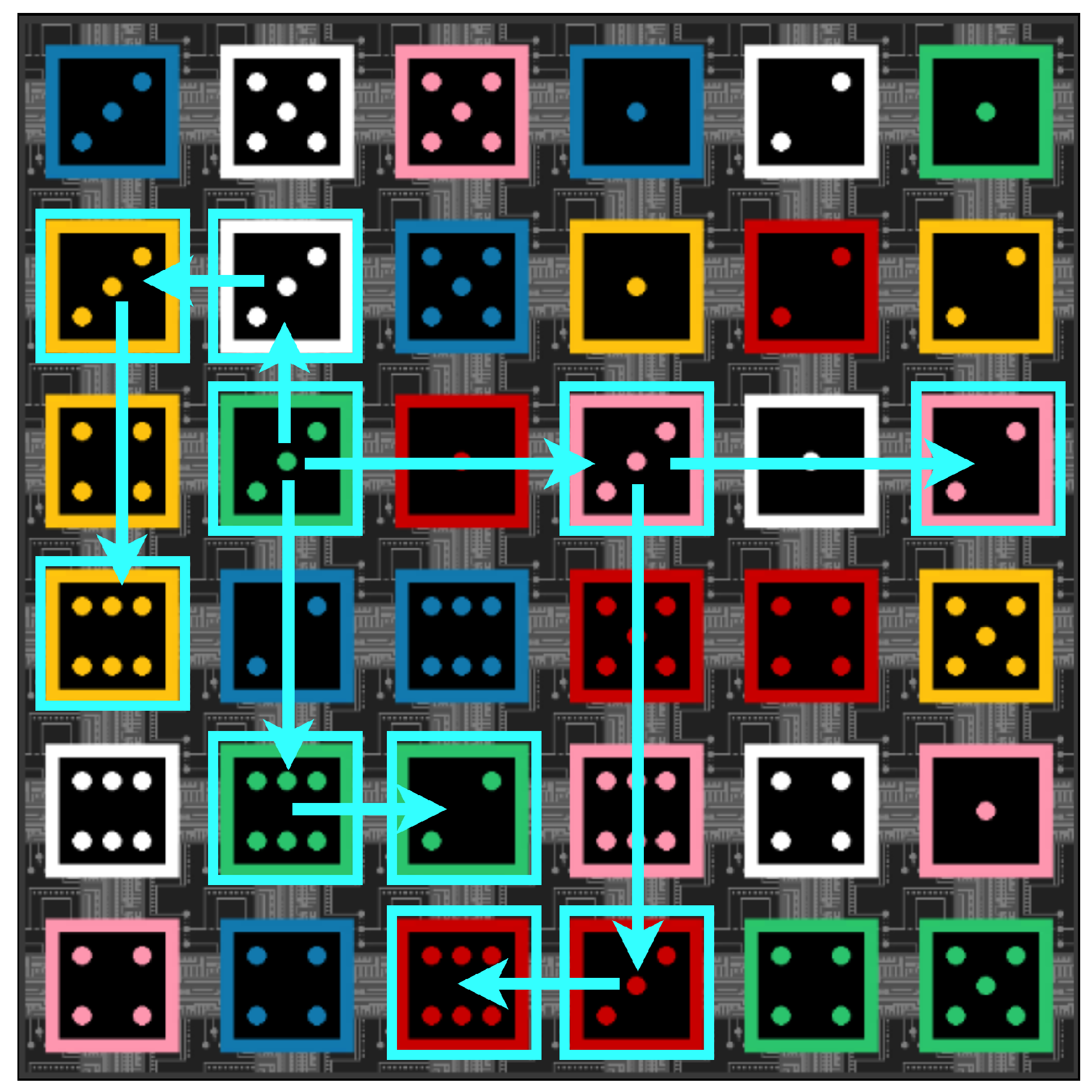
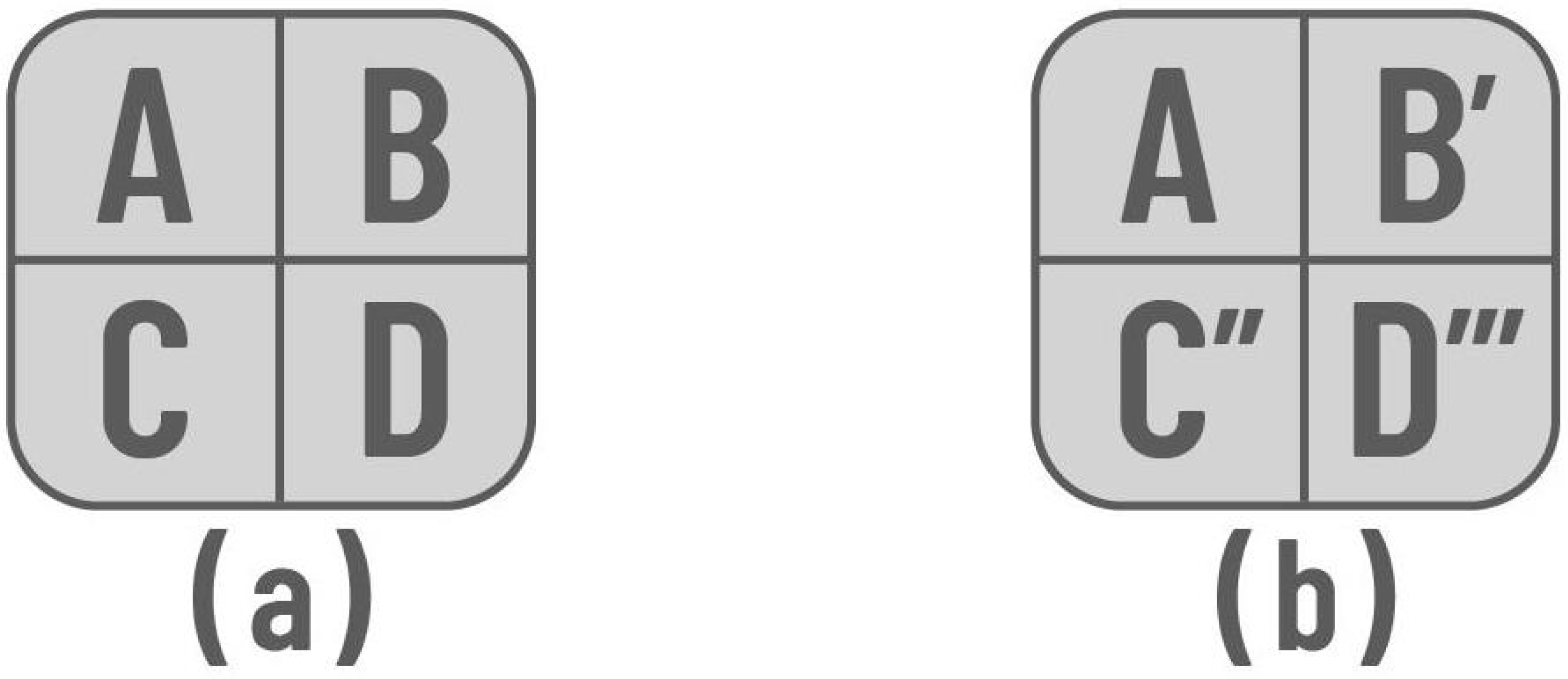


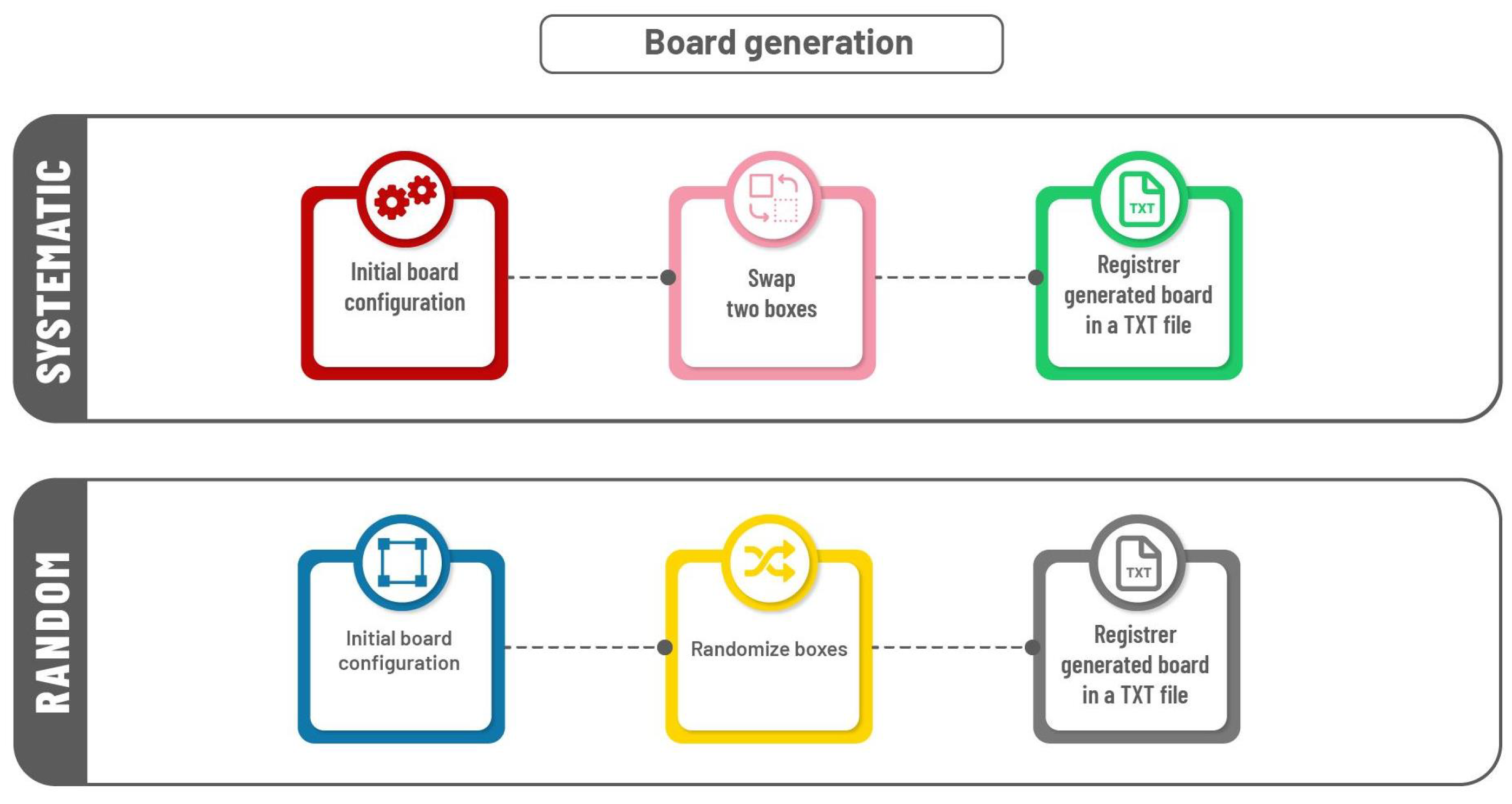
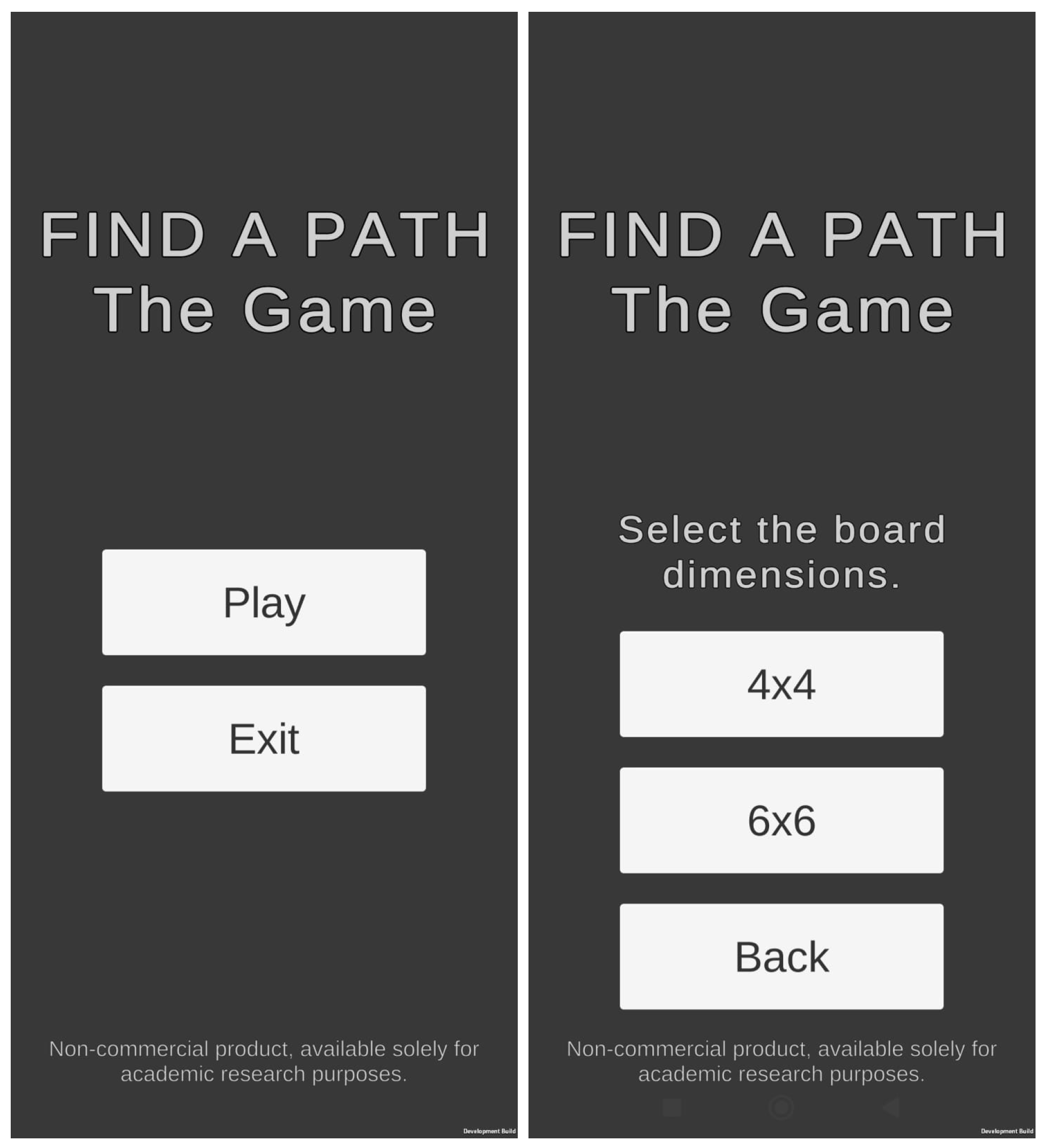
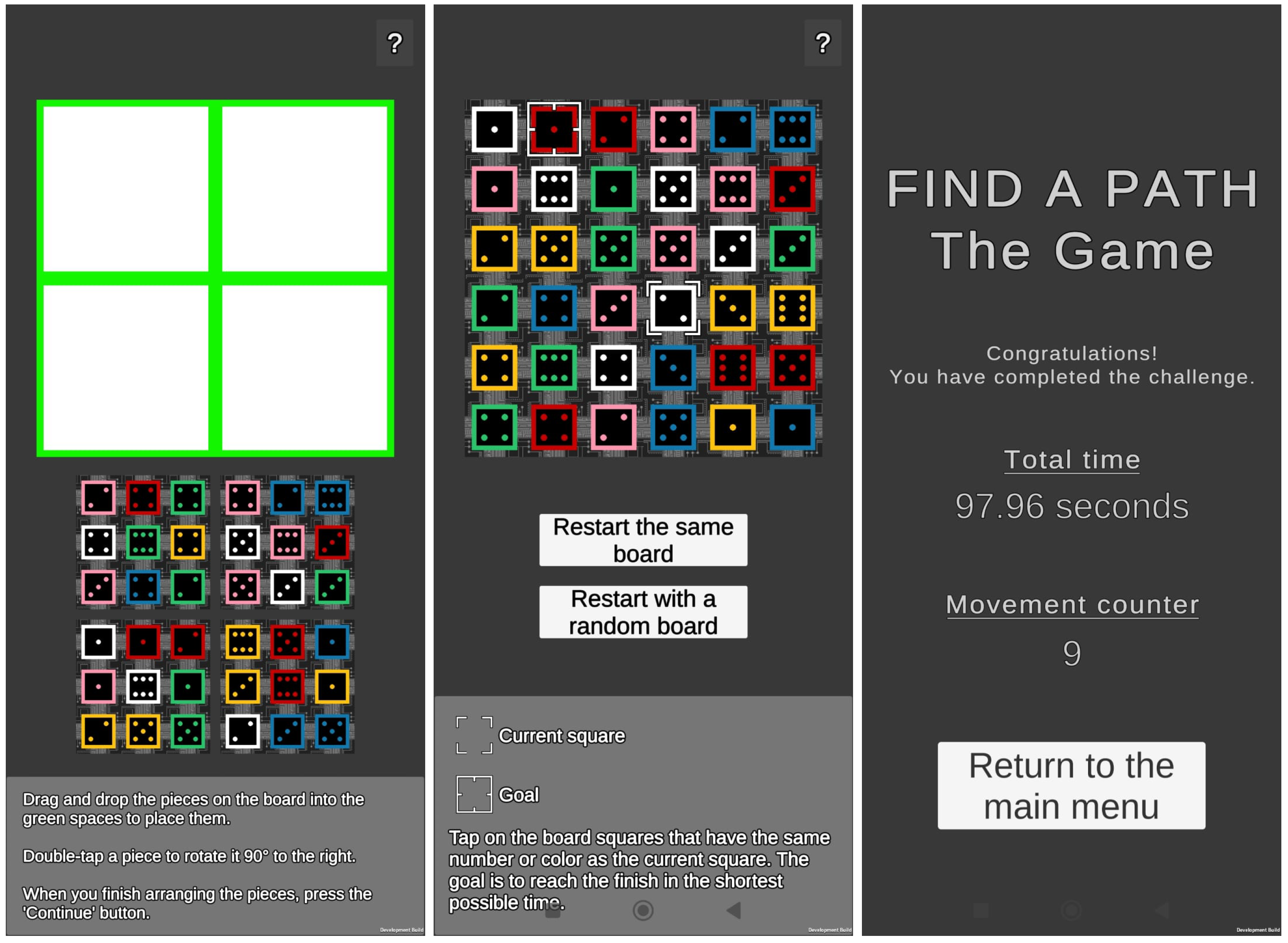
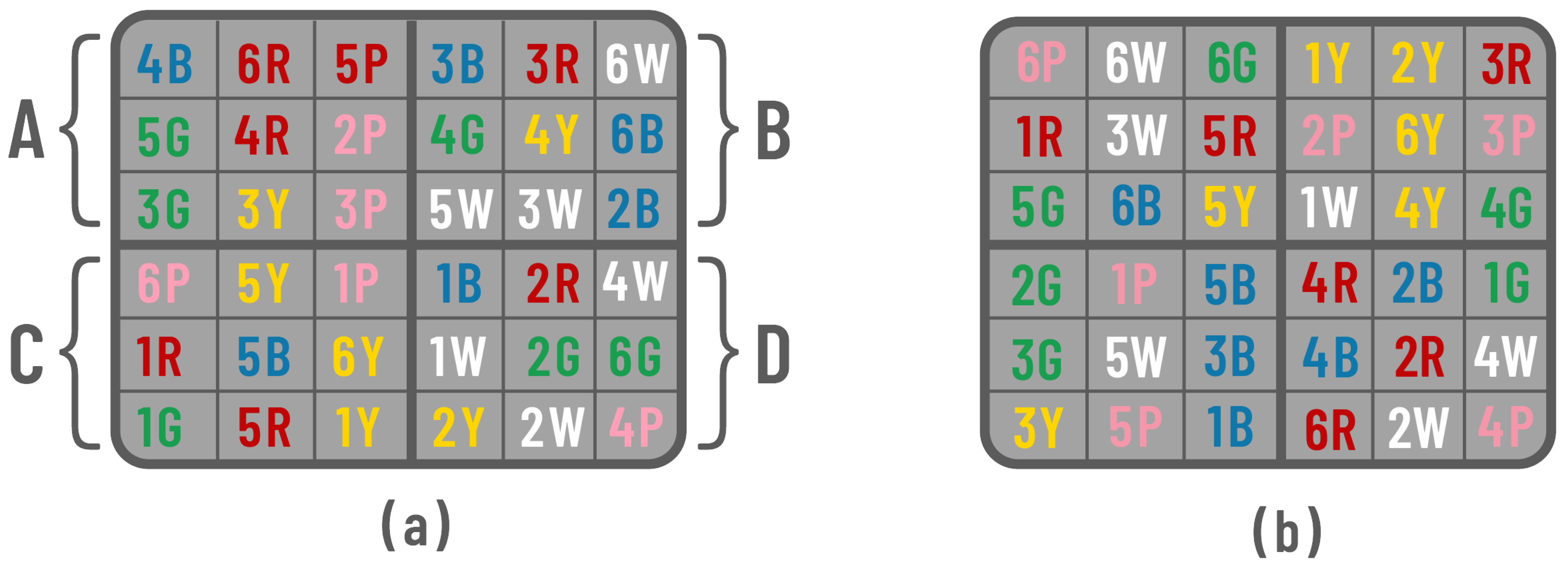
| Dimension | Quantity | Time |
|---|---|---|
| 4 × 4 boards | 968 | 1 h |
| 6 × 6 boards | 973 | 10 h |
| Original Board | Generated Board | |||
|---|---|---|---|---|
| Type of Link | Average of Links | Standard Deviation | Average of Links | Standard Deviation |
| Single link | 2.06 | 1.54 | 2.62 | 1.32 |
| Double link | 7.90 | 2.82 | 8.78 | 2.99 |
| Triple link | 12.78 | 2.59 | 10.18 | 2.42 |
| Quadruple link | 8.74 | 2.48 | 9.44 | 2.83 |
| Quintuple link | 2.68 | 1.24 | 3.74 | 1.86 |
| Sextuple link | 1.58 | 1.22 | 1.14 | 1.00 |
| Septuple link | 0.24 | 0.47 | 0.10 | 0.30 |
| Octuple link | 0.02 | 0.14 | 0.00 | 0.00 |
| Total links | 36 | 36 | ||
Disclaimer/Publisher’s Note: The statements, opinions and data contained in all publications are solely those of the individual author(s) and contributor(s) and not of MDPI and/or the editor(s). MDPI and/or the editor(s) disclaim responsibility for any injury to people or property resulting from any ideas, methods, instructions or products referred to in the content. |
© 2024 by the authors. Licensee MDPI, Basel, Switzerland. This article is an open access article distributed under the terms and conditions of the Creative Commons Attribution (CC BY) license (https://creativecommons.org/licenses/by/4.0/).
Share and Cite
Silva, K.; Besoain, F.; Barriga, N.A. Analysis, Generation, and Validation of New Boards for the Game Micro Robots. Appl. Sci. 2024, 14, 9416. https://doi.org/10.3390/app14209416
Silva K, Besoain F, Barriga NA. Analysis, Generation, and Validation of New Boards for the Game Micro Robots. Applied Sciences. 2024; 14(20):9416. https://doi.org/10.3390/app14209416
Chicago/Turabian StyleSilva, Kevin, Felipe Besoain, and Nicolas A. Barriga. 2024. "Analysis, Generation, and Validation of New Boards for the Game Micro Robots" Applied Sciences 14, no. 20: 9416. https://doi.org/10.3390/app14209416
APA StyleSilva, K., Besoain, F., & Barriga, N. A. (2024). Analysis, Generation, and Validation of New Boards for the Game Micro Robots. Applied Sciences, 14(20), 9416. https://doi.org/10.3390/app14209416







